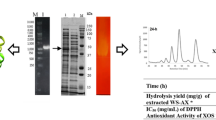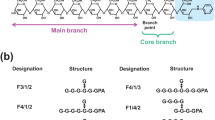Abstract
β-Xylosidases catalyze the hydrolysis of xylooligosaccharides to xylose in the final step of hemicellulose degradation. AnBX, which is a GH3 β-xylosidase from Aspergillus niger, has a high catalytic efficiency toward xyloside substrates. In this study, we report the three-dimensional structure and the identification of catalytic and substrate binding residues of AnBX by performing site-directed mutagenesis, kinetic analysis, and NMR spectroscopy-associated analysis of the azide rescue reaction. The structure of the E88A mutant of AnBX, determined at 2.5-Å resolution, contains two molecules in the asymmetric unit, each of which is composed of three domains, namely an N-terminal (β/α)8 TIM-barrel-like domain, an (α/β)6 sandwich domain, and a C-terminal fibronectin type III domain. Asp288 and Glu500 of AnBX were experimentally confirmed to act as the catalytic nucleophile and acid/base catalyst, respectively. The crystal structure revealed that Trp86, Glu88 and Cys289, which formed a disulfide bond with Cys321, were located at subsite -1. Although the E88D and C289W mutations reduced catalytic efficiency toward all four substrates tested, the substitution of Trp86 with Ala, Asp and Ser increased the substrate preference for glucoside relative to xyloside substrates, indicating that Trp86 is responsible for the xyloside specificity of AnBX. The structural and biochemical information of AnBX obtained in this study provides invaluable insight into modulating the enzymatic properties for the hydrolysis of lignocellulosic biomass.
Key points
• Asp288 and Glu500 of AnBX are the nucleophile and acid/base catalyst, respectively
• Glu88 and the Cys289-Cys321 disulfide bond are crucial for the catalytic activity of AnBX
• The W86A and W86S mutations in AnBX increased the preference for glucoside substrates







Similar content being viewed by others
Data availability
The data supporting this study's findings are available from the corresponding authors upon reasonable request.
References
Afonine PV, Grosse-Kunstleve RW, Echols N, Headd JJ, Moriarty NW, Mustyakimov M, Terwilliger TC, Urzhumtsev A, Zwart PH, Adams PD (2012) Towards automated crystallographic structure refinement with phenix.refine. Acta Crystallogr D Biol Crystallogr 68:352–367. https://doi.org/10.1107/S0907444912001308
Braman J, Papworth C, Greener A (1996) Site-directed mutagenesis using double-stranded plasmid DNA templates. Methods Mol Biol 57:31–44. https://doi.org/10.1385/0-89603-332-5:31
Choengpanya K, Arthornthurasuk S, Wattana-amorn P, Huang WT, Plengmuankhae W, Li YK, Kongsaeree PT (2015) Cloning, expression, and characterization of β-xylosidase from Aspergillus niger ASKU28. Protein Expr Purif 115:132–140. https://doi.org/10.1016/j.pep.2015.07.004
Dan S, Marton I, Dekel M, Bravdo BA, He S, Withers SG, Shoseyov O (2000) Cloning, expression, characterization, and nucleophile identification of family 3, Aspergillus niger β-glucosidase. J Biol Chem 275:4973–80. https://doi.org/10.1074/jbc.275.7.4973
Emsley P, Lohkamp B, Scott WG, Cowtan K (2010) Features and development of Coot. Acta Crystallogr D Biol Crystallogr 66:486–501. https://doi.org/10.1107/S0907444910007493
Harvey AJ, Hrmova M, De Gori R, Varghese JN, Fincher GB (2000) Comparative modeling of the three-dimensional structures of family 3 glycoside hydrolases. Proteins 41:257–69. https://doi.org/10.1002/1097-0134(20001101)41:2%3C257::aid-prot100%3E3.0.co;2-c
Holm L, Rosenström P (2010) Dali server: conservation mapping in 3D. Nucleic Acids Res 38:W545–W549. https://doi.org/10.1093/nar/gkq366
Hrmova M, Varghese JN, De Gori R, Smith BJ, Driguez H, Fincher GB (2001) Catalytic mechanisms and reaction intermediates along the hydrolytic pathway of a plant β-D-glucan glucohydrolase. Structure 9:1005–1016. https://doi.org/10.1016/s0969-2126(01)00673-6
Kabsch W (2010) XDS. Acta Crystallogr D Biol Crystallogr 66:125–132. https://doi.org/10.1107/S0907444909047337
Kojima K, Sunagawa N, Mikkelsen NE, Hansson H, Karkehabadi S, Samejima M, Sandgren M, Igarashi K (2022) Comparison of glycoside hydrolase family 3 β-xylosidases from basidiomycetes and ascomycetes reveals evolutionarily distinct xylan degradation systems. J Biol Chem 298:101670. https://doi.org/10.1016/j.jbc.2022.101670
Krissinel E, Henrick K (2007) Inference of macromolecular assemblies from crystalline state. J Mol Biol 372:774–797. https://doi.org/10.1016/j.jmb.2007.05.022
Li YK, Chir J, Tanaka S, Chen FY (2002) Identification of the general acid/base catalyst of a family 3 β-glucosidase from Flavobacterium meningosepticum. Biochemistry 41:2751–2759. https://doi.org/10.1021/bi016049e
Lin LL, Rumbak E, Zappe H, Thompson JA, Woods DR (1990) Cloning, sequencing and analysis of expression of a Butyrivibrio fibrisolvens gene encoding a β-glucosidase. J Gen Microbiol 136:1567–1576
Litzinger S, Fischer S, Polzer P, Diederichs K, Welte W, Mayer C (2010) Structural and kinetic analysis of Bacillus subtilis N-acetylglucosaminidase reveals a unique Asp-His dyad mechanism. J Biol Chem 285:35675–35684. https://doi.org/10.1074/jbc.M110.131037
Macdonald SS, Blaukopf M, Withers SG (2015) N-Acetylglucosaminidases from CAZy family GH3 are really glycoside phosphorylases, thereby explaining their use of histidine as an acid/base catalyst in place of glutamic acid. J Biol Chem 290:4887–4895. https://doi.org/10.1074/jbc.M114.621110|
Nieto-Domínguez M, Fernández de Toro B, de Eugenio LI, Santana AG, Bejarano-Muñoz L, Armstrong Z, Méndez-Líter JA, Asensio JL, Prieto A, Withers SG, Cañada FJ, Martínez MJ (2020) Thioglycoligase derived from fungal GH3 β-xylosidase is a multi-glycoligase with broad acceptor tolerance. Nat Commun 11:1–16. https://doi.org/10.1038/s41467-020-18667-3
Paal K, Ito M, Withers SG (2004) Paenibacillus sp. TS12 glucosylceramidase: kinetic studies of a novel sub-family of family 3 glycosidases and identification of the catalytic residues. Biochem J 378:141–149. https://doi.org/10.1042/BJ20031028
Pozzo T, Pasten JL, Karlsson EN, Logan DT (2010) Structural and functional analyses of β-glucosidase 3B from Thermotoga neapolitana: A thermostable three-domain representative of glycoside hydrolase 3. J Mol Biol 397:724–739. https://doi.org/10.1016/j.jmb.2010.01.072
Ramírez-Escudero M, Del Pozo MV, Marín-Navarro J, González B, Golyshin PN, Polaina J, Ferrer M, Sanz-Aparicio J (2016) Structural and functional characterization of a ruminal β-glycosidase defines a novel subfamily of glycoside hydrolase family 3 with permuted domain topology. J Biol Chem 291:24200–24214. https://doi.org/10.1074/jbc.m116.747527
Roe JH, Rice EW (1947) A photometric method for the determination of free pentoses in animal tissues. J Biol Chem 173:507–512. https://doi.org/10.1016/S0021-9258(18)57423-8
Rye CS, Withers SG (2000) Glycosidase mechanisms. Curr Opin Chem Biol 4:573–580. https://doi.org/10.1016/s1367-5931(00)00135-6
Schröder PS, Boer C, McGregor NGS, Rowland RJ, Moroz O, Blagova E, Reijngoud J, Arentshorst M, Osborn D, Morant MD, Abbate E, Stringer MA, Krogh KBRM, Raich L, Rovira C, Berrin J, van Wezel GP, Ram AFJ, Florea BI, van der Marel GA, Codeé JDC, Wilson KS, Wu L, Davies GJ, Overkleeft HS (2019) Dynamic and functional profiling of xylan-degrading enzymes in Aspergillus secretomes using activity-based probes. ACS Cent Sci 5:1067–1078. https://doi.org/10.1021/acscentsci.9b00221
Seidle HF, McKenzie K, Marten I, Shoseyov O (2005) Huber RE (2005) Trp-262 is a key residue for the hydrolytic and transglucosidic reactivity of the Aspergillus niger family 3 β-glucosidase: substitution results in enzymes with mainly transglucosidic activity. Arch Biochem Biophys 444:66–75. https://doi.org/10.1016/j.abb.2005.09.013
Stubbs KA, Balcewich M, Mark BL, Vocadlo DJ (2007) Small molecule inhibitors of a glycoside hydrolase attenuate inducible AmpC-mediated β-lactam resistance. J Biol Chem 282:21382–21391. https://doi.org/10.1074/jbc.M700084200
Suzuki K, Sumitani J, Nam YW, Nishimaki T, Tani S, Wakagi T, Kawaguchi T, Fushinobu S (2013) Crystal structures of glycoside hydrolase family 3 β-glucosidase 1 from Aspergillus aculeatus. Biochem J 452:211–221. https://doi.org/10.1042/BJ20130054
Thongpoo P, McKee LS, Araújo AC, Kongsaeree PT, Brumer H (2013) Identification of the acid/base catalyst of a glycoside hydrolase family 3 (GH3) β-glucosidase from Aspergillus niger ASKU28. Biochim Biophys Acta 1830:2739–2749. https://doi.org/10.1016/j.bbagen.2012.11.014
Thongpoo P, Srisomsap C, Chokchaichamnankit D, Kitpreechavanich V, Svasti J, Kongsaeree PT (2014) Purification and characterization of three β-glycosidases exhibiting high glucose tolerance from Aspergillus niger ASKU28. Biosci Biotechnol Biochem 78:1167–1176. https://doi.org/10.1080/09168451.2014.915727
Varghese JN, Hrmova M, Fincher GB (1999) Three-dimensional structure of a barley β-D-glucan exohydrolase, a family 3 glycosyl hydrolase. Structure 7:179–190. https://doi.org/10.1016/s0969-2126(99)80024-0
Yoshida E, Hidaka M, Fushinobu S, Koyanagi T, Minami H, Tamaki H, Kitaoka M, Katayama T, Kumagai H (2010) Role of a PA14 domain in determining substrate specificity of a glycoside hydrolase family 3 β-glucosidase from Kluyveromyces marxianus. Biochem J 431:39–49. https://doi.org/10.1042/BJ20100351
Acknowledgements
We acknowledge the Paul Scherrer Institute, Villigen, Switzerland for the provision of synchrotron radiation beamtime (proposal numbers 20191094 and 20191134) and the staff at beamline X06SA.
Funding
This study was financially supported by a research grant (NRCT5-RSA63002-09) from the National Research Council of Thailand and Kasetsart University, and by the ISB program from the Faculty of Science, Kasetsart University. WK is a recipient of the Royal Golden Jubilee scholarship from the Thailand Research Fund and the National Research Council of Thailand. KC was a recipient of the Ph.D. scholarship from the Office of the Higher Education Commission, Thailand.
Author information
Authors and Affiliations
Contributions
TT, YL and PTK conceived and designed the research. WK, KC, TT, PW and WL conducted the experiments. YL and AK contributed reagents and analytical tools. WK, KC, TT, PW, MO and PTK analyzed the data. WK, PW and PTK wrote the manuscript. All authors read and approved the manuscript.
Corresponding author
Ethics declarations
Ethics approval
This article does not involve any studies with human participants or animal-based experiments.
Conflict of interest
The authors declare no competing interests.
Additional information
Publisher's note
Springer Nature remains neutral with regard to jurisdictional claims in published maps and institutional affiliations.
Supplementary Information
Below is the link to the electronic supplementary material.
Rights and permissions
Springer Nature or its licensor (e.g. a society or other partner) holds exclusive rights to this article under a publishing agreement with the author(s) or other rightsholder(s); author self-archiving of the accepted manuscript version of this article is solely governed by the terms of such publishing agreement and applicable law.
About this article
Cite this article
Kaenying, W., Choengpanya, K., Tagami, T. et al. Crystal structure and identification of amino acid residues for catalysis and binding of GH3 AnBX β-xylosidase from Aspergillus niger. Appl Microbiol Biotechnol 107, 2335–2349 (2023). https://doi.org/10.1007/s00253-023-12445-z
Received:
Revised:
Accepted:
Published:
Issue Date:
DOI: https://doi.org/10.1007/s00253-023-12445-z




